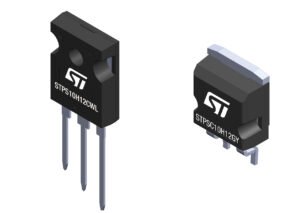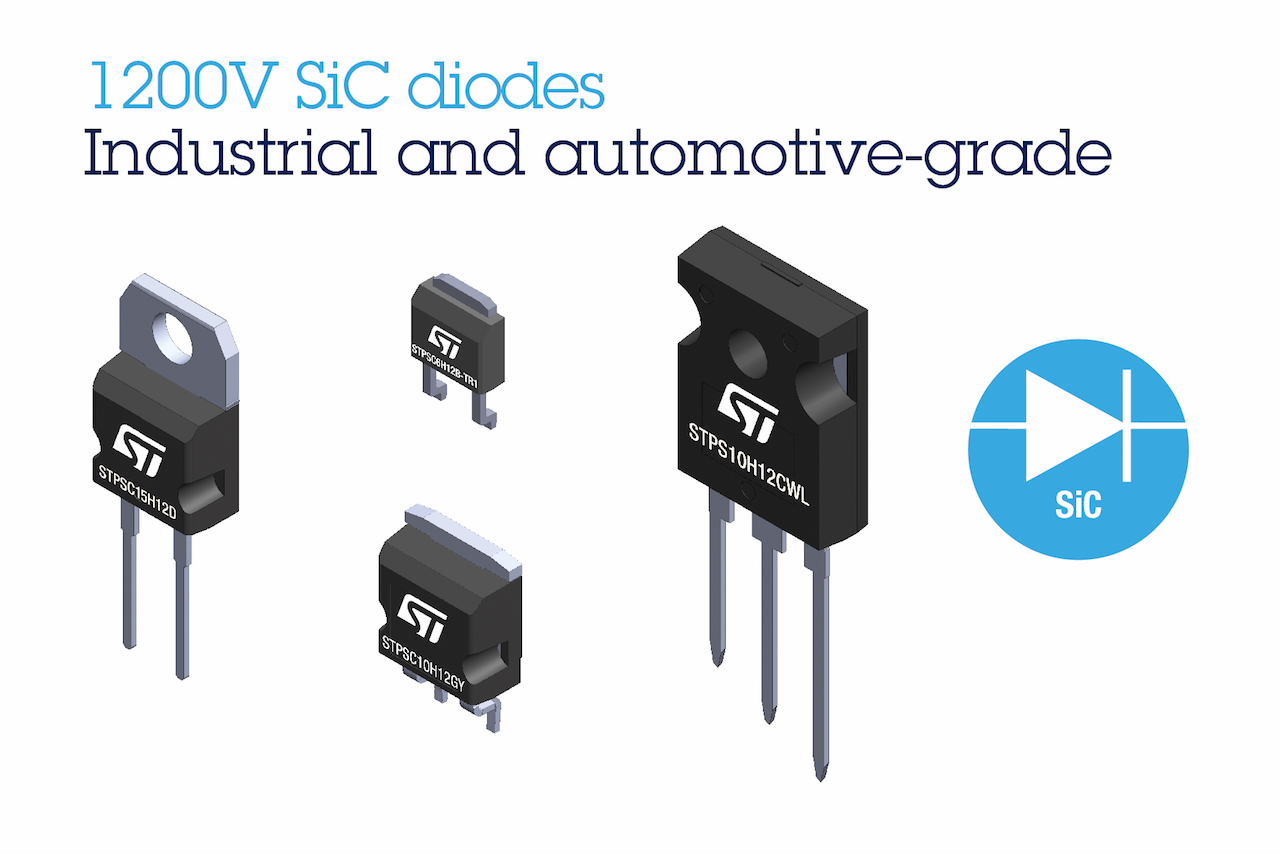ST is announcing the qualification of a wide range of 1200 V Silicon Carbide (SiC) diodes, which stretch from 2 A to 40 A, and are in mass production now. These new products are the result of years of experience. ST launched its first mass-market SiC diodes 10 years ago, and as we have seen on this blog, the company leads major innovations that rely on the special properties of Silicon Carbide. In the world of 1200 V diodes, ST’s breakthroughs translate into components that are so efficient and robust, they are certified for the automotive industry – AEC-Q101 – while offering some of the biggest power savings on the market.
The 1200 V SiC Diodes With the Lowest Forward Voltage Drop Ever
The latest devices have the lowest Forward Voltage Drop (VF) in the industry today. As the role of a diode is to ensure electricity flows a specific way, while blocking current in the opposite direction, it is important to measure the drop in voltage, when the diode is used by the circuit, to have a sense of its impact on the overall efficiency. This is especially critical in the types of applications that require 1200 V SiC diodes. By choosing the device with the lowest Forward Voltage Drop, engineers can use more cost-effective components that have a lower rating. Since we are talking about big products like cars, or solar panels, the savings add up very quickly.
As an example, we can take the STPSC10H12-Y (1200 V, 10 A), which has a typical VF of only 1.35 V at 25 ºC, and a maximum value of 1.50 V, whereas some of ST’s main competitors have measurements that are between 10 % and 20 % higher. Furthermore, the ST device also has the smallest difference between the typical and maximum value. This is crucially important to ensure the repeatability of the diode’s performance, regardless of the vastly different operating situations. This is a fundamental feature in vehicles or other products that must function over a wide range of environments.
Comprehensive Performance

This robustness and efficiency is also manifested in the fact that ST’s 1200 V SiC diodes have low leakage current (IR), which is a representation of the device’s quality. On the other hand, its high surge non-repetitive forward current (IFSM) is an asset. This value represents the maximum peak current permitted to flow through the diode. At 7 times the typical forward current (10 A), it is easy to understand why ST’s devices already have automotive-grade certifications.
However, one of the most impressive characteristics of the new 1200 V SiC diodes is their thermal resistance junction to case (Rth(j-c)). This value measures the device’s ability to transfer the heat produced by the operating components of the diode to the package (“case”), which is usually the metal part of the package or an arbitrary point around pin 1 for fully insulated packages.
The Right Compromises

On the STPSC10H12-Y, the typical Rth(j-c) value is 0.65 ºC/W. Although, the difference with the competition is often small, those diodes will be used in very demanding systems that can sometimes require 10 kW. As a result, the smallest gains in heat dissipation, or Forward Voltage Drop, have astonishing effects on the final design, and its performance, especially since engineers target a 97 % to 98 % efficiency.
The lesson we can draw is that before setting out to make these 1200 V diodes, ST thoroughly analyzed the market, and understood that customers were primarily after extreme efficiency. Teams will choose Silicon Carbide devices because of outstanding constraints that require a completely different set of materials and solutions. As a result, these diodes almost never run at extremely high frequencies, and ST is the only company that truly takes advantage of that to offer the lowest VF ever.
Special Guarantees
Another “feature” that makes ST’s diodes special is the company’s ability to guarantee production volume. Having produced SiC diodes for a decade means ST can ensure a smooth process, regardless of the final product, and the size of its market. For instance, the company has two raw wafer suppliers for the 1200 V diodes, which means that independent supply chains and multiple channels can protect a production from unforeseen events. To top it off, ST is able to grow the epitaxial layer in-house, which is another reliable source of the diodes’ base material.
1200 V diodes are enabling innovations in increasingly popular industries like electric cars, and their chargers, as well as solar panels, and ST not only ensure that companies can benefit from new levels of efficiency, it guarantees that the demand for a product will never be stifled by a lack of repeatability of the diode’s performance, or poor yields, and disappointing manufacturing processes. To know more about ST’s 1200 V diodes, please visit its website.
